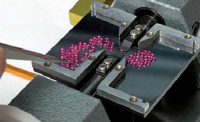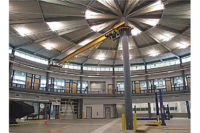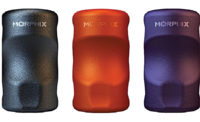Aircraft manufacturing has changed significantly in recent years. Instead of being assembled in one spot, most aircraft today are built on moving assembly lines similar to those used by automakers. Despite this evolution, however, many aerospace manufacturers still rely on hydraulic jacks, tuggers or overhead cranes to move aircraft through the various manufacturing stages.
Bombardier Aerospace used jacks at its Toronto assembly plant until switching to Airfloat wheeled air caster transporters several years ago. Also called automated pneumatic guided vehicles (APGVs), these transporters easily and safely move 6-ton aircraft fuselages.
Each transporter measures more than 20 feet long and is built of structural tubes and laser-cut steel plates. The transporter also features front and rear air caster skids, and front optical sensors that follow a marked line on the plant floor to bring the transporter to various workstations.
Prior to assembly, the transporter, with fuselage on it, is towed to the start of the assembly line. The shop air line is then attached to the transporter and opened. As air flows into the transporter (200 scfm at 80 psi), its air caster skids are deployed to lift the transporter and fuselage a few millimeters off the ground.
The transporter’s optical sensors are then activated to follow the marked line to the first workstation. There the skids are deployed, the fuselage is raised and assembly is performed. When assembly is complete, the skids are retracted, the transporter is lowered and moved to the next workstation. After assembly is completed at the final workstation, the transporter is towed to the next assembly line.
When necessary, the transporter can be wirelessly steered between workstations by an operator using a radio controller. Additionally, the durable wheels on the transporter enable it to be towed, whether empty or loaded, on rough surfaces or outdoors.
Another aerospace company benefitting from Airfloat’s air-bearing technology is GE Aviation, which manufactures advanced carbon fiber components at its Batesville, MS, factory for the GEnx jet engine. Workers there routinely move bulky parts containers and tooling fixtures weighing 5,000 to 12,000 pounds around the 300,000-square-foot facility.
A few years ago, management was looking for a way to move and position the fixtures that did not involve traditional wheeled carts and ride-on tuggers. Both of these machines were difficult to maneuver in confined spaces and damaged the plant’s concrete floors.
GE hired Airfloat to create a custom air-bearing platform that easily lifts the fixtures so they can be safely moved in and out of tight spaces. The platform consists of front and back wheeled Lift Glide air skids that support two side frames, and a steerable Power Tugger that mounts to the front skid.
After two workers adjust the width of the frames to accommodate the fixture, it is placed on the frames. The tugger operator then connects the tugger to the front skid. When he squeezes the tugger’s right handle trigger, air flows to both skids, which raise up and lift the platform and fixture off the ground.
The operator slowly moves the platform where it needs to go, with the assistance of the two workers. One worker serves as a spotter, while the other one monitors the air line to ensure it stays connected and doesn’t kink. Upon arriving at his destination, the operator releases the trigger to interrupt air flow so the platform lowers to the ground.
With the platform, workers safely move a fixture within 5 minutes around sensitive electrical cabinets and building columns. In comparison, the same task took 45 minutes with carts and tuggers.
For more information on APGVs and air-bearing platforms, call 800-888-0018 or visit www.airfloat.com.





